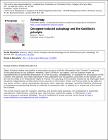| dc.contributor.author | MARTIN, SEAMUS | en |
| dc.date.accessioned | 2015-02-16T16:19:12Z | |
| dc.date.available | 2015-02-16T16:19:12Z | |
| dc.date.issued | 2011 | en |
| dc.date.submitted | 2011 | en |
| dc.identifier.citation | Martin, S.J., Oncogene-induced autophagy and the Goldilocks principle, Autophagy, 7, 8, 2011, 922-923 | en |
| dc.identifier.other | Y | en |
| dc.identifier.uri | http://hdl.handle.net/2262/73233 | |
| dc.description | PUBLISHED | en |
| dc.description.abstract | Although several oncogenes enhance
autophagic flux, the molecular
mechanism and consequences of onco
-
gene-induced autophagy remain to be
clarified. We have recently shown that
expression of oncogenic H-Ras
V12
pro
-
motes autophagy through upregulation
of Beclin 1 and the BH3-only protein
Noxa. H-Ras-expressing cells undergo
autophagic cell death as a result of Noxa-
mediated displacement of Mcl-1 and
Bcl-x
L
from Beclin 1. Oncogenic H-Ras-
induced death is attenuated through
knockdown of
BECLIN 1
,
ATG5
or
ATG7
, or through overexpression of
Mcl-1, Bcl-2, Bcl-x
L
and their close rela
-
tives. T | en |
| dc.description.sponsorship | We thank Science Foundation Ireland
(08/IN.1/B2031) and the European
Union Marie Curie Research Training
Network (ApopTrain) for support of the
work discussed herein | en |
| dc.format.extent | 922-923 | en |
| dc.language.iso | en | en |
| dc.relation.ispartofseries | Autophagy | en |
| dc.relation.ispartofseries | 7 | en |
| dc.relation.ispartofseries | 8 | en |
| dc.rights | Y | en |
| dc.subject | autophagic flux | en |
| dc.subject.lcsh | autophagic flux | en |
| dc.title | Oncogene-induced autophagy and the Goldilocks principle | en |
| dc.type | Journal Article | en |
| dc.contributor.sponsor | Science Foundation Ireland (SFI) | en |
| dc.type.supercollection | scholarly_publications | en |
| dc.type.supercollection | refereed_publications | en |
| dc.identifier.peoplefinderurl | http://people.tcd.ie/martinsj | en |
| dc.identifier.rssinternalid | 86822 | en |
| dc.rights.ecaccessrights | openAccess | |
| dc.contributor.sponsorGrantNumber | 08/IN.1/B2 | en |




